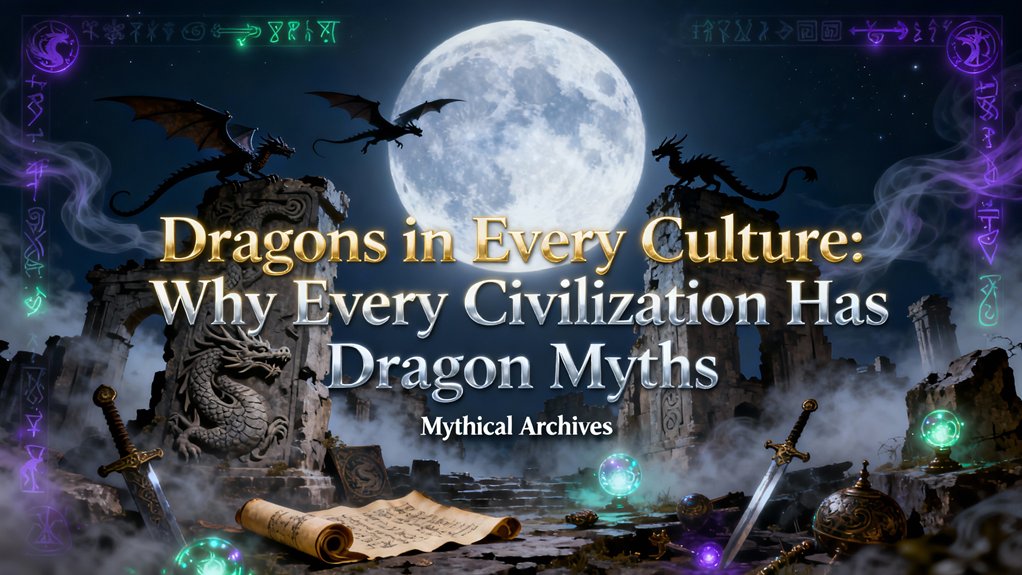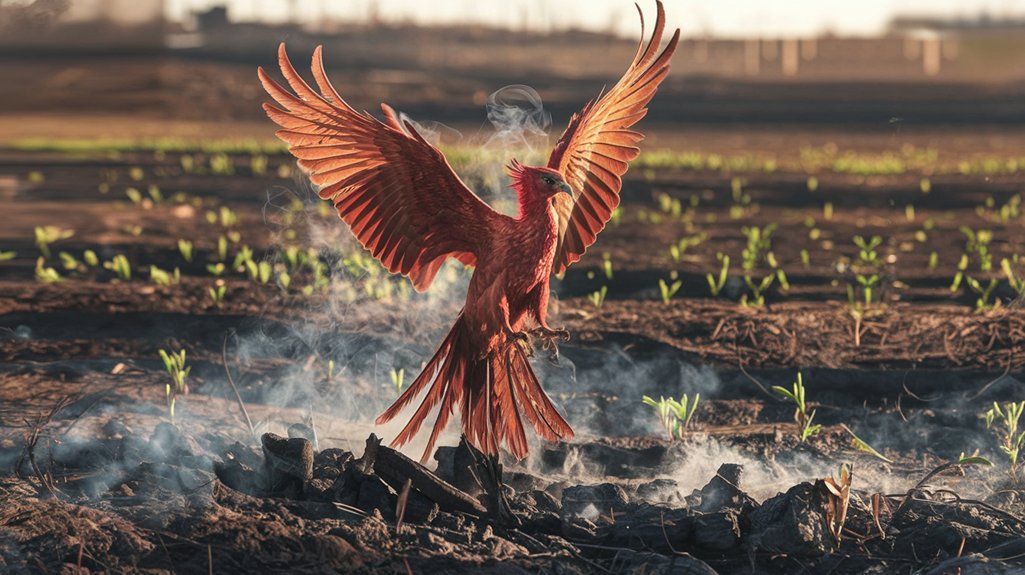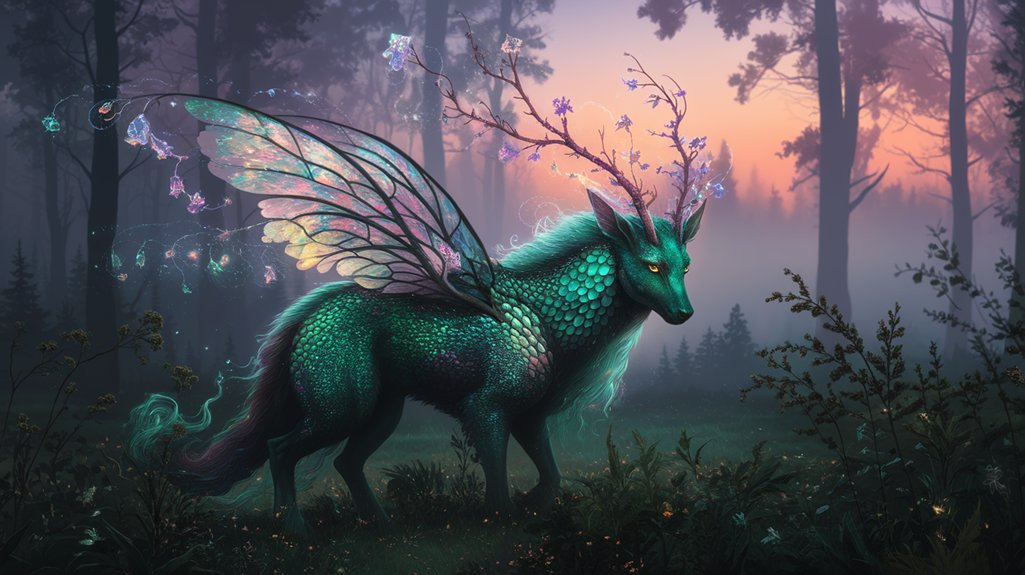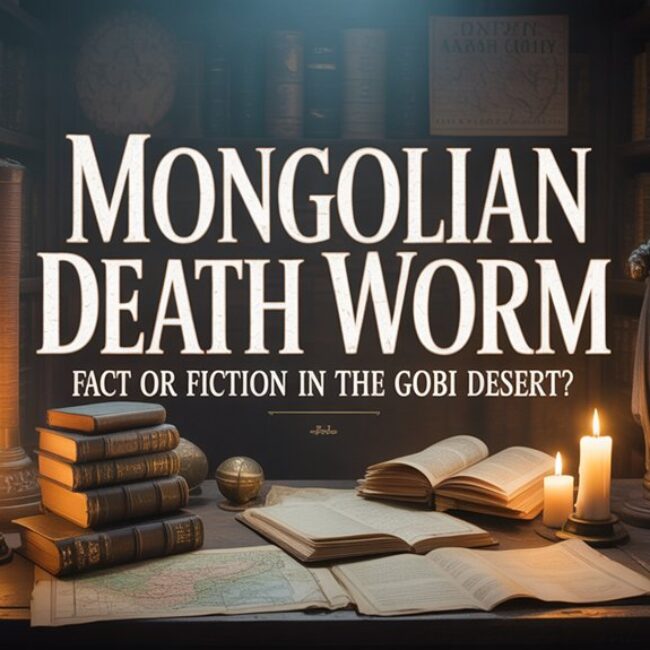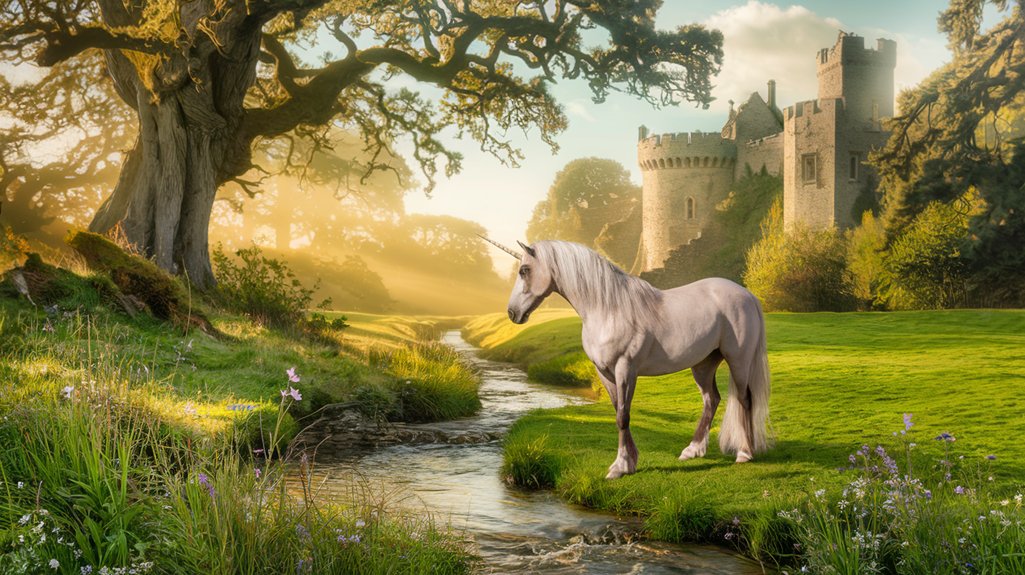You'll find dragon myths emerging independently across every inhabited continent because ancient peoples discovered fossilized remains—protoceratops skulls, mammoth bones, massive vertebrae—and constructed chimeric explanations within their cultural frameworks. These petrified leviathans merged with humanity's encoded predator-fears from evolutionary memory: serpents, raptors, apex hunters synthesized into ultimate threats. Eastern *lóng* embodied celestial wisdom while European wyrms guarded subterranean hoards, yet both served identical functions—validating sovereignty, demarcating liminal boundaries between civilization and wilderness, explaining catastrophic natural forces through narratives that converted mysterious bones into living mythology spanning forty millennia of human consciousness, with deeper patterns awaiting your discovery.
Key Takeaways
- Dragon myths emerged independently across civilizations as ancient peoples interpreted fossilized dinosaur and megafauna bones without modern scientific frameworks.
- Dragons embody primal evolutionary fears by combining features of humanity's ancestral predators: serpents, large cats, and raptorial birds.
- Eastern dragons symbolize benevolent wisdom and natural harmony, while Western dragons represent malevolent chaos and spiritual corruption.
- Dragons served crucial social functions including validating royal authority, marking territorial boundaries, and guarding sacred knowledge across cultures.
- Universal dragon characteristics—serpentine bodies, elemental powers, guardian roles—reflect shared human experiences with natural disasters and predatory threats.
The Global Distribution of Dragon Myths Across Continents
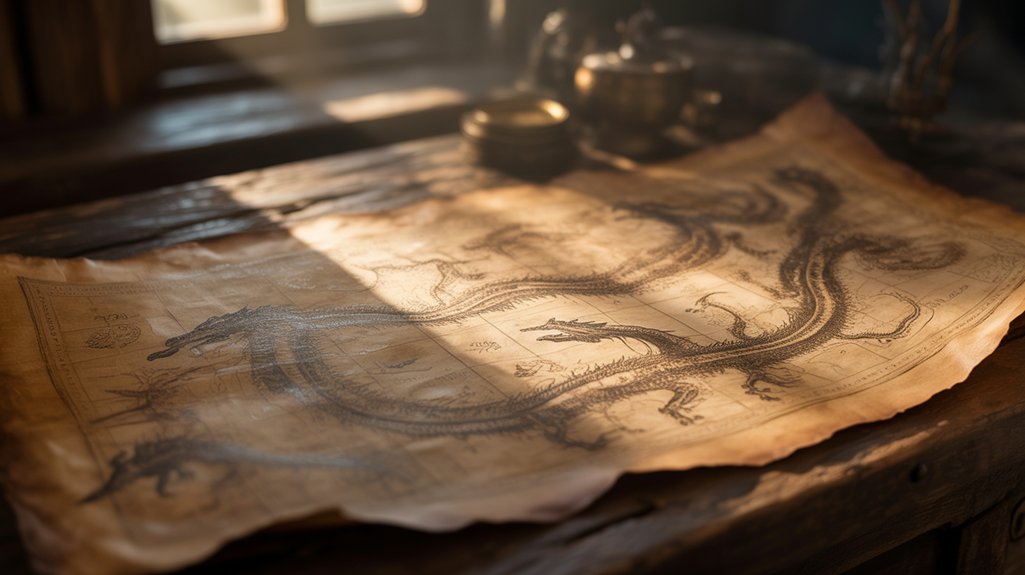
When scholars trace the cartography of dragon lore across the ancient world, they discover not isolated myths but rather a remarkable pattern—serpentine deities and winged behemoths emerging independently from civilizations separated by vast oceans and impenetrable mountain ranges.
You'll find these eldritch creatures coiling through Mesopotamian cylinder seals circa 3000 BCE, soaring across Chinese jade carvings, writhing through Nordic sagas. The cultural significance transcends mere folklore.
Consider the mythological parallels: Tiamat's primordial chaos, Quetzalcoatl's feathered sovereignty, Apophis devouring the sun. Each tradition birthed chimeric guardians without cross-pollination, without cultural transmission.
Dragons emerged from Australia's Rainbow Serpent to Britain's wyverns, from Japanese ryu to Mesoamerican serpent-gods. This wasn't coincidence. These weren't borrowed tales.
The pattern reveals something deeper about human consciousness, about how you and your ancestors interpreted the world's mysteries.
Independent invention. Parallel evolution. Dragons materialized wherever humans sought to name the ineffable, to give form to nature's terrible majesty.
Eastern Dragons: Symbols of Wisdom and Celestial Power
Unlike their Western counterparts—those malevolent hoarders of treasure and devourers of maidens—the dragons of East Asia emerged as beneficent cosmological forces, serpentine embodiments of imperial authority and natural harmony.
Eastern dragons ascended as divine protectors and rain-bringers, their serpentine majesty embodying cosmic order rather than chaos.
You'll find these chimeric beings coiling through Chinese consciousness since the Shang Dynasty (1600-1046 BCE), their antlered heads and pearl-clutching claws representing wisdom symbolism that transcended mere mythology. These celestial guardians commanded rain, rivers, and seasonal floods—life-giving powers rather than destructive impulses.
The *lóng* possessed no wings yet soared through clouds with ease, their undulating forms painted across imperial robes in gold thread, marking divine right to rule. Eldritch yet benevolent.
In Japan, the *ryū* guarded sacred waters and Buddhist temples, while Vietnamese *rồng* birthed entire dynasties from their loins.
You're witnessing creatures woven into governmental legitimacy itself, their scales shimmering with philosophical weight—yin and yang made manifest in sinuous flesh, breathing mists that nourished civilizations rather than immolating them.
European Dragons: From Treasure Hoarders to Christian Allegories
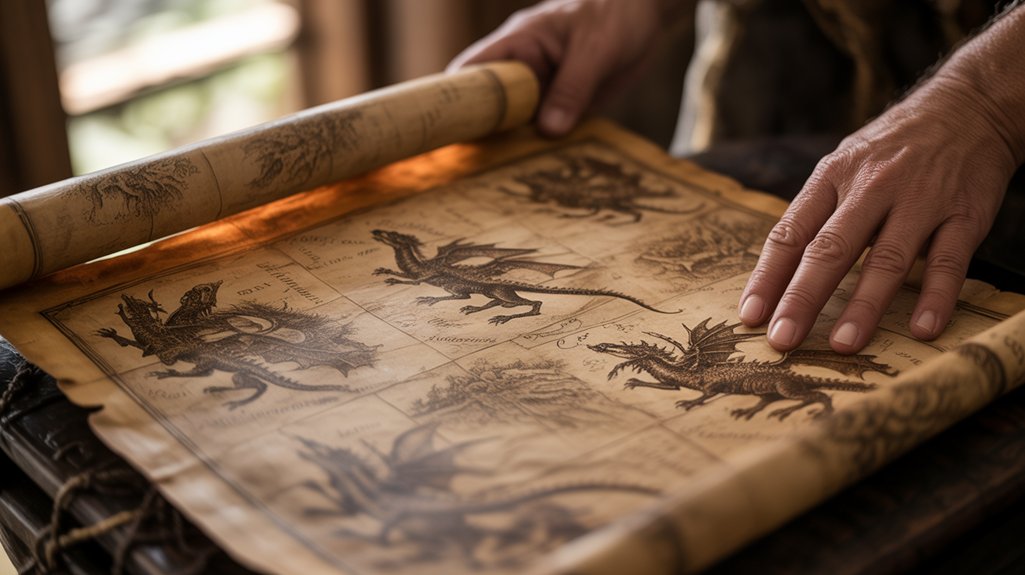
You'll find European dragons altered across millennia, evolving from the eldritch wyrms coiled around pagan gold hoards—those primordial guardians whose serpentine forms emerged from Germanic and Norse traditions circa 500 BCE through 1000 CE—into the sulfurous embodiments of sin and chaos that medieval Christianity reimagined between the 4th and 15th centuries.
These ancient beasts, once revered as liminal keepers of earthly wealth and forbidden knowledge, became chimeric adversaries in theological allegory: scaled manifestations of humanity's spiritual corruption requiring saintly conquest.
The smoke-wreathed hoarder transmuted into the devil's servant.
The Viking Age Norse particularly wove dragons into their sagas and poems as creatures intertwined with the pursuit of gold, prestige, and power—the very elements that defined their worldview of achieving greatness through formidable deeds.
Pagan Gold-Guarding Serpents
Before Christianity swept across the northern reaches of Europe, serpentine guardians coiled themselves around glittering hoards in the dark recesses of barrows and mountain caves. These gold guarding serpents embodied pagan symbolism far deeper than mere avarice—they represented the dangerous threshold between mortal ambition and divine retribution.
| Culture | Guardian Serpent |
|---|---|
| Norse | Fáfnir, the cursed dwarf |
| Germanic | Nibelung hoard-wyrm |
| Anglo-Saxon | Beowulf's bane-dragon |
| Celtic | The Peist of treasure-mounds |
| Slavic | Zmey Gorynych variations |
You'll find these eldritch creatures weren't obstacles—they were warnings. The treasure itself carried doom, corrupting whoever claimed it. Touch the gold, awaken the serpent, inherit the curse. This wasn't Christian morality. This was older wisdom about power's corrosive nature.
Medieval Christian Symbolism
When the Church's shadow stretched across Europe's pagan landscapes, the serpent underwent a conversion more profound than any draconic shapeshifting—it became Satan's chosen avatar, the primordial deceiver coiled around humanity's downfall.
Medieval iconography altered dragons into cautionary chimeric emblems: Sankt Georg's lance-pierced wyrm, Archangel Michael trampling eldritch beasts, Margaret of Antioch emerging triumphant from serpentine jaws.
These dragon allegories weren't mere decoration—they encoded theological warfare between divine order and chaotic rebellion. You'll find them carved into cathedral capitals, illuminated across manuscript margins, woven into tapestries where saints confronted scaled temptation.
The Germanic *drache*, the French *dragon*, the English *worm*—all converged into Christianity's ultimate adversary, representing everything your soul must conquer: pride, avarice, spiritual corruption.
The ancient guardian became the enemy.
The Fossil Discovery Theory: Did Dinosaur Bones Inspire Dragon Tales?
You've witnessed dragons manifesting across continents, their serpentine forms carved into stone and woven through epic narratives—but what if these chimeric beasts emerged not from pure imagination, but from tangible ossified remains unearthed by ancient hands?
Consider the archaeological evidence: fossilized Protoceratops skulls discovered along the Silk Road trade routes, mammoth bones excavated from Greek quarries circa 400 BCE, and plesiosaur vertebrae scattered across medieval Chinese construction sites, all predating modern paleontological science by millennia.
Without taxonomic frameworks or evolutionary theory to contextualize these eldritch skeletal giants, your ancestors interpreted massive femurs, elongated skulls, and serrated teeth through the only lens available—myth-making that changed cryptic bone fragments into living, fire-breathing leviathans guarding primordial treasures.
Ancient Fossil Sites Discovered
As paleontologists excavate ancient strata across continents—from the Gobi Desert's Cretaceous beds to the Sichuan Basin's Jurassic formations—a compelling thesis emerges: the dragon myths proliferating across disparate civilizations may have originated not from collective imagination alone, but from direct encounters with fossilized leviathans embedded in stone.
You'll find evidence where ancient civilizations intersected with fossil discoveries:
- Protoceratops skulls in Mongolia, their beaked visages suggesting griffins
- Mammoth bones in Greek quarries, interpreted as cyclopic titans
- Dinosaur vertebrae in Chinese pharmacology, catalogued as “dragon bones”
These chimeric remains spoke an eldritch language to those who unearthed them.
Without modern paleontological frameworks, your ancestors constructed mythologies explaining these ossified giants—transforming geological truth into sacred narrative, stone memory into living legend.
Bone Interpretation Without Science
Before anatomical science codified skeletal architecture into taxonomic order, those who stumbled upon lithified remains possessed only their cultural lexicon—a vocabulary of monsters, demons, and divine beasts—to decode these petrified enigmas.
You'd find a massive skull emerging from eroded cliff faces, jawbones spanning your outstretched arms, vertebrae like wagon wheels. What taxonomy existed for such eldritch anatomy?
The bone myths flourished precisely because they bridged observable reality with cultural significance.
Chinese scholars encountering colossal remains catalogued them as *long* bones—dragon remnants confirming ancient texts. Greek chroniclers interpreted protoceratops skulls in Scythian goldfields as griffin evidence.
These weren't misinterpretations. They were rational frameworks.
Without comparative anatomy, without evolutionary theory, these chimeric explanations possessed internal logic. The bones demanded meaning. Culture supplied it.
Cross-Cultural Skeletal Evidence
When paleontologist Othniel Charles Marsh excavated Jurassic Morrison Formation strata in 1877, he didn't invent dragon mythology—he validated millennia of skeletal interpretation.
Ancient peoples encountered these same ossified remains, constructing chimeric beings from fragmentary evidence. You'll find cross cultural connections emerging wherever exposed fossils punctured earth's surface:
- Chinese villagers grinding “dragon bones” discovered megafauna skulls in Sichuan limestone
- Greek shepherds stumbling upon Protoceratops skeletons in Gobi trade routes
- Native Americans incorporating massive vertebrae into creation narratives
These skeletal interpretations weren't primitive superstition—they represented sophisticated attempts at paleontological reconstruction without modern frameworks.
The eldritch forms proto-scientists imagined from disarticulated remains mirror creatures we've since named Diplodocus and *Allosaurus*. Freedom from institutional dogma allowed independent observation. Raw empiricism.
In Iron Age Southern Africa, kingdoms like Mapungubwe may have similarly encountered fossilized remains in their northern territories near the Limpopo River, potentially influencing their own mythological traditions.
Serpent Gods of Mesoamerica: Quetzalcoatl and Kukulkan
Across the volcanic highlands and limestone lowlands of Mesoamerica, the feathered serpent reigned as perhaps the most enduring and complex deity in pre-Columbian religious consciousness—a chimeric fusion of quetzal bird and rattlesnake that embodied the fundamental duality permeating Aztec and Maya cosmology.
You'll find Quetzalcoatl symbolism threaded through Teotihuacan's stone facades (circa 200 CE), where serpent representations undulate across temple platforms, their scales carved with mathematical precision.
The Maya knew him as Kukulkan worship flourished in Chichen Itza, where twice yearly the equinox sun casts serpentine shadows down El Castillo's steps—an eldritch performance of light and stone.
These weren't mere monsters to placate. They represented wind, creation, the planet Venus. Knowledge itself. In Mesoamerican mythology, serpents bridged earth and sky, chaos and order, destruction and rebirth.
They demanded neither slavery nor blind submission, but understanding—recognition that change, not stasis, governs existence.
Aboriginal Australian Rainbow Serpents and Water Dragons
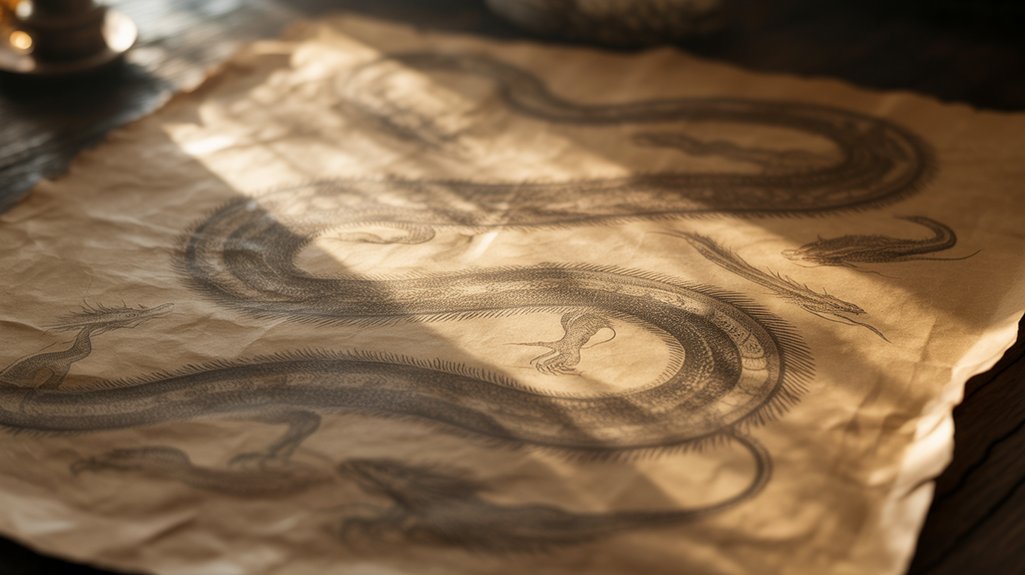
Across the ancient continent of Australia, where the Dreamtime's eldritch narratives stretch back perhaps 65,000 years, you'll encounter the Rainbow Serpent—a chimeric entity that coils through waterways, billabongs, and the deep psychic substrate of Aboriginal cosmology.
These water dragons didn't simply inhabit creation stories; they *were* creation itself, carving rivers with serpentine bodies, filling sacred waterholes with their very essence, establishing the fundamental architecture of law and land.
The Rainbow Serpent emerges from these traditions as both life-giver and destroyer, a being whose chromatic scales reflect the covenant between humans and the eternal forces governing water, fertility, and cosmic order.
Rainbow Serpent Creation Stories
Among the oldest continuous cultural traditions on Earth, Aboriginal Australian cosmology preserves narratives of the Rainbow Serpent—a primordial being whose sinuous form carved rivers, gorges, and waterholes across the continent during the Dreamtime, that eternal epoch when ancestral spirits shaped the world's contours.
You'll discover these creation myths aren't mere folklore but living protocols governing relationship with Country itself.
The Rainbow Serpent's metamorphic acts established cosmic order:
- Water sovereignty: Springs emerged where the serpent rested, underground aquifers marking its subterranean journeys
- Topographical genesis: Mountain ranges rose from its coiled body, valleys formed beneath its weight
- Life-giving authority: It bestowed or withheld water, determining which lands flourished
This eldritch entity embodies both creator and destroyer—a chimeric force demanding respect.
Transgression invites devastation.
Water Holes and Serpents
When Aboriginal custodians approach certain waterholes with heightened vigilance, they're observing protocols refined across sixty millennia—these aren't arbitrary taboos but survival knowledge encoded in serpent narratives.
The Rainbow Serpent inhabits billabongs where crocodiles lurk, where flash floods convert placid pools into torrents. Water symbolism here transcends mere resource management.
Sacred sites map genuine dangers: submerged logs, undertows, territorial wildlife. Serpent mythology becomes geographic database, transmitting survival intelligence through generations without written language.
The eldritch power attributed to these chimeric beings—part snake, part kangaroo, part fish—enforces respect for water's dual nature as life-giver and destroyer.
Children learn: that waterhole belongs to the serpent. Translation: approach cautiously, test depths, watch for predators.
Ancient wisdom, pragmatic knowledge, wrapped in scales and dreamtime.
Dreamtime Dragon Symbolism
The Rainbow Serpent operates simultaneously as ecological cartographer, cosmological architect, and moral legislator—three functions that collapse Western categorical boundaries between natural history, theology, and jurisprudence.
You'll discover this eldritch entity threading through dreamtime stories, establishing waterways and sacred law with each sinuous movement across the primordial Australian continent.
Dragon rituals honoring this chimeric being reveal profound autonomy within Aboriginal governance:
- Communities maintained sovereign authority over sacred sites without colonial interference
- Initiates learned territorial boundaries through oral transmission, not imposed borders
- Ceremonial knowledge remained decentralized across kinship networks
The Serpent's iridescent scales map sovereignty itself—each color designating totemic affiliations, water rights, and autonomous jurisdiction.
This creature doesn't merely symbolize freedom; it architecturally embeds self-determination within landscape, memory, and cosmological order.
The Psychology Behind Dragon Myths: Fear, Predators, and Human Evolution
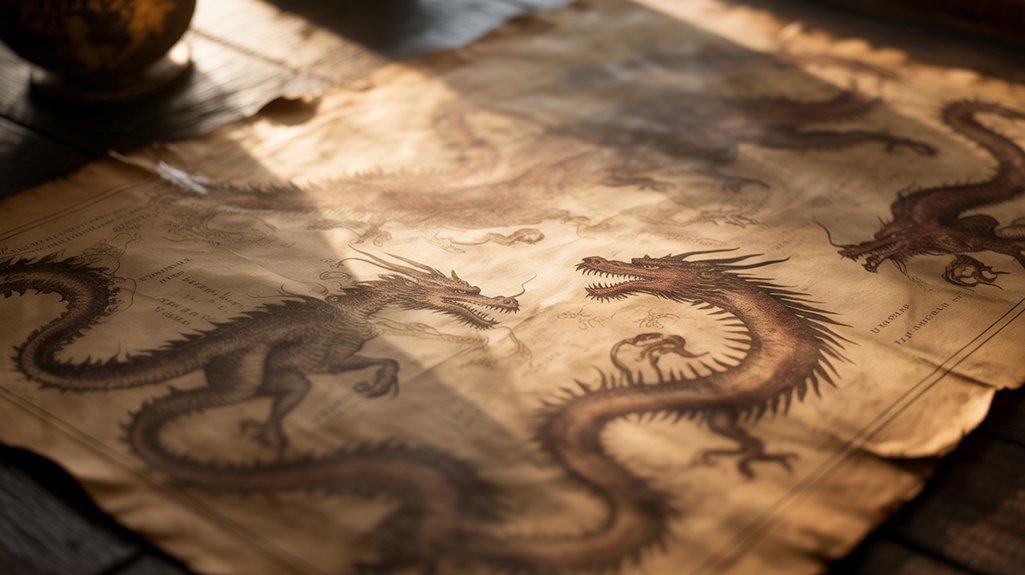
Deep within our ancestral memory lies something primal—an encoded terror that transcends cultural boundaries and geological epochs. You've inherited this fear response, carved into your neural pathways through millennia of evolutionary adaptation. Your ancestors survived because they recognized composite threats—serpents that constrict, raptors that strike from above, great cats that stalk from shadows.
Dragons embody this chimeric synthesis. They're your brain's ultimate predator.
| Predator Element | Dragon Feature | Evolutionary Threat |
|---|---|---|
| Serpent | Scaled body, venom | Ground-level ambush |
| Raptor | Wings, talons, keen sight | Aerial assault |
| Carnivore | Fangs, claws | Direct confrontation |
| Reptile | Cold intelligence | Unpredictable behavior |
| Fire | Breath weapon | Elemental destruction |
Neuroscientist Joseph LeDoux's research confirms you're hardwired to detect these patterns. Your amygdala fires before conscious thought processes eldritch forms lurking in peripheral vision. This isn't superstition—it's survival machinery, functioning perfectly across every civilization that's evergazed into darkness.
Common Characteristics: Why Dragons Share Similar Traits Worldwide
Across five continents and spanning 40,000 years of human civilization, dragons manifest with startling consistency—a phenomenon that defies conventional explanations of independent cultural development.
You'll discover these chimeric beings share fundamental attributes that transcend geographic boundaries, suggesting deeper archetypal imagery embedded within human consciousness itself.
Consider the universal elements:
- Serpentine bodies coiling through primordial waters and subterranean domains
- Elemental dominion over fire, storms, and catastrophic natural forces
- Guardian roles protecting treasure, sacred knowledge, or dimensional thresholds
The cultural significance extends beyond mere coincidence. These eldritch creatures embody your ancestors' attempts to comprehend chaos, power, and change.
Whether Chinese *long*, Mesopotamian Tiamat, or Mesoamerican Quetzalcoatl, you're witnessing archetypal patterns that emerge from collective human experience—responses to predatory threats, natural disasters, and the numinous unknown.
Dragons represent liminal consciousness itself, bridging rational understanding with primal recognition of forces beyond mortal comprehension.
Dragons as Symbols of Natural Forces and Environmental Powers
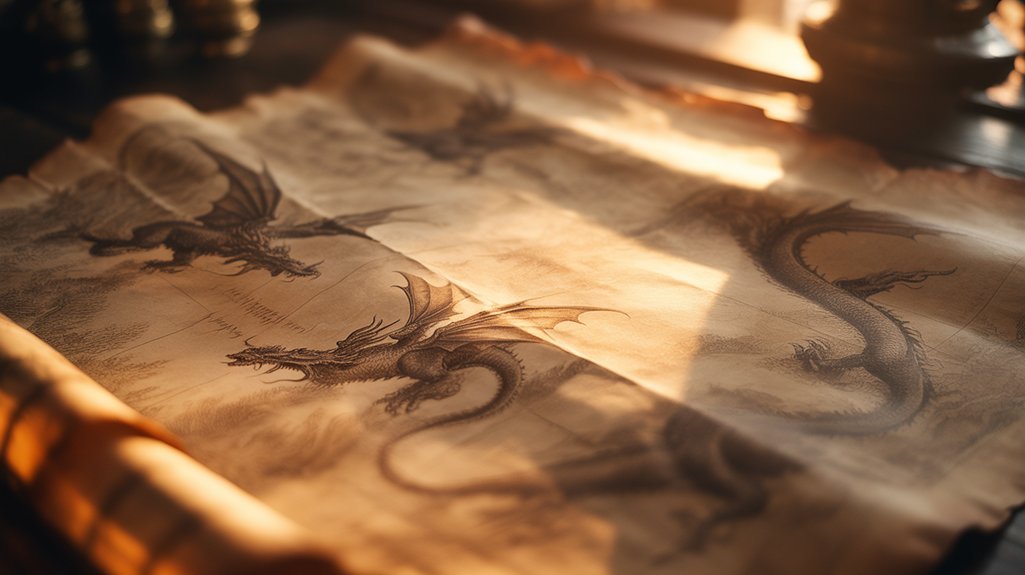
When volcanic ash blackened Bronze Age skies and tsunamis obliterated coastal settlements, your ancestors didn't perceive random geological events—they witnessed dragons manifesting their terrible sovereignty over earth's primordial forces.
These eldritch creatures embodied the untamed powers that could unmake civilizations overnight: typhoons became scaled serpents churning the Pacific, earthquakes morphed into subterranean wyrms writhing beneath China's Yellow River valley, droughts materialized as fire-breathing chimeric beasts withholding rain from Mesopotamian farmlands.
Understanding natural disasters through draconic mythology wasn't primitive superstition—it was cultural resilience codified into transmissible knowledge.
When you named the destructive force, you could negotiate with it, appease it, perhaps redirect its fury. Dragons gave your forebears agency against chaos.
The thunder-serpent Apep threatened Ra's solar journey nightly. Storm dragons guarded Korea's mountain passes.
These weren't metaphors. They were survival frameworks, allowing communities to contextualize catastrophe within narratives where human courage, sacrifice, and wisdom mattered against overwhelming environmental powers.
The Cultural Functions of Dragon Mythology Through History
Beyond their role as personified natural catastrophes, dragons functioned as civilization's most versatile mythological infrastructure—simultaneously encoding legal authority, mediating cosmological shifts, legitimizing dynastic power, and establishing boundaries between the developed and the wild.
You'll find these serpentine entities serving as cultural identity markers across millennia, their chimeric forms adapting to each society's deepest anxieties and aspirations.
Through mythological adaptation, dragon narratives performed essential functions:
- Sovereignty validation: Chinese emperors claimed draconic descent, while European monarchs commissioned dragon-slaying heraldry to demonstrate righteous dominion.
- Territorial demarcation: Dragons marked liminal spaces—cave mouths, mountain passes, unmapped waters—where civilization's order dissolved into eldritch wilderness.
- Knowledge gatekeeping: These creatures guarded forbidden wisdom, from Ladon's golden apples to Fáfnir's runic secrets.
Ancient scribes understood what modern scholarship confirms: dragon myths weren't mere entertainment but foundational texts establishing who possessed authority, which lands warranted conquest, and what knowledge remained permissibly accessible.
Sacred cartography rendered visible.
Frequently Asked Questions
Are There Any Cultures That Have No Dragon or Serpent Myths?
You'll find virtually no human civilization entirely devoid of serpent symbolism—these eldritch forms manifest universally.
Arctic peoples like the Inuit developed fewer dragon narratives, their cosmologies favoring ice-bound spirits over scaled leviathans. Yet even here, aquatic serpents emerge.
Cultural variations exist in prominence, not absence. The chimeric dragon-serpent archetype transcends geographical boundaries, suggesting something primal, perhaps ancestral memory encoded in humanity's collective unconscious.
Complete absence remains extraordinarily rare, almost impossible to document conclusively.
When Did the First Recorded Dragon Myth Appear in Human History?
You'll find the earliest dragon myths emerging from ancient Mesopotamia around 4000 BCE, where the chimeric Tiamat coiled through Babylonian creation tablets.
These mythological origins predate written language itself—serpentine deities carved into Neolithic stones whisper older truths.
Ancient civilizations like Sumer gave form to primordial chaos through scaled embodiments.
The eldritch power you sense in these creatures? It's humanity's first attempt at naming the unnameable, binding cosmic forces into sinuous, fire-breathing flesh.
Do Modern Dragon Depictions in Movies Accurately Reflect Ancient Dragon Myths?
You'll find modern interpretations dramatically diverge from ancient sources.
Hollywood's fire-breathing beasts, while spectacular, often homogenize diverse traditions—conflating Eastern serpentine deities with Western chimeric monsters. The cultural significance gets diluted.
Ancient dragons embodied cosmic forces: Tiamat's primordial chaos, Quetzalcoatl's wisdom, the Vedic Vritra's drought.
Today's CGI creatures rarely capture that eldritch power. True understanding requires you to breach the veil separating entertainment from sacred mythology.
Modern depictions entertain; ancient myths evolved.
Why Are Dragons Often Depicted as Fire-Breathing in Western Cultures?
You'll find fire symbolism emerging from proto-Indo-European traditions where serpentine chaos-beasts embodied destructive metamorphosis.
The cultural significance deepened through Medieval Christianity—dragons became infernal agents, their flames mirroring hellfire's purifying torment.
Yet there's something deeper: lightning storms over ancient settlements, volcanic eruptions consuming Bronze Age villages.
Your ancestors witnessed earth breathing flame, transmuting these eldritch encounters into chimeric guardians.
Fire represented sovereign power, untamed knowledge, the boundary between civilization's order and primordial wildness you've always sensed lurking beyond domesticated reality.
Have Any Dragon Myths Been Proven to Describe Real Extinct Animals?
You'll find no definitive proof, though the possibility haunts paleontological discourse.
Dragon fossils—misinterpreted remains of ancient reptiles like Megalania or crocodilian ancestors—may have seeded these chimeric legends.
The eldritch bones of dinosaurs, unearthed by pre-scientific civilizations, could've inspired serpentine deities.
Yet dragons transcend simple fossil explanations; they're archetypal amalgamations, not taxonomic records.
The boundary between remembered megafauna and pure mythology remains tantalizingly unresolved, dwelling in that liminal space where empirical evidence meets collective ancestral memory.
Conclusion
You've encountered dragons across five continents, five epochs, five distinct civilizations—yet their chimeric forms persist with uncanny similarity. Coincidence? Perhaps. But consider: fossils embedded in ancient strata, psychological predator-templates encoded in your synapses, serpentine rivers carving eldritch patterns across primordial landscapes. These convergences aren't mere accident. They're humanity's collective response to forces beyond comprehension—natural, psychological, numinous. Dragons emerge where your ancestors confronted the ineffable, altering terror into mythology, chaos into meaning.
